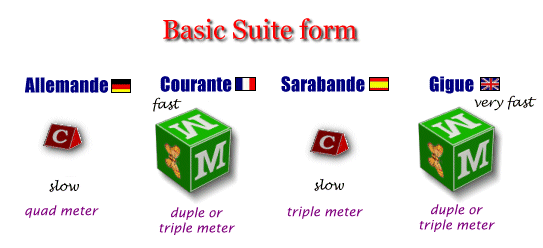|
Composers

Bach

Telemann

Handel
|
 Suite
A musical form that originated
as a series of dance tunes conflicting in character, rhythm and tempo
(speed). The suite was at its peak in the renainssance Suite
A musical form that originated
as a series of dance tunes conflicting in character, rhythm and tempo
(speed). The suite was at its peak in the renainssance and baroque
and baroque .
It was born at the beginning of the 16th century, when the musical world
shifted its attention from vocal .
It was born at the beginning of the 16th century, when the musical world
shifted its attention from vocal (sung) to instrumental
(sung) to instrumental (played) music. Then, composers turned to
folk dances
(played) music. Then, composers turned to
folk dances ,
drawing their inspiration from these dances. Thus the suite was crystallized
as a combination of dances from different countries. The
four original dances that crystalized into the suite of the late 17th century
were the Allemande ,
drawing their inspiration from these dances. Thus the suite was crystallized
as a combination of dances from different countries. The
four original dances that crystalized into the suite of the late 17th century
were the Allemande  (German
(German ),
Courante ),
Courante  (French
(French ),
Sarabande ),
Sarabande  (Spanish
(Spanish )
and Gigue )
and Gigue  (English
(English ).
These have appeared in nearly every suite written ever since, yet unfixed
dances were added between the third and the fourth (minuette ).
These have appeared in nearly every suite written ever since, yet unfixed
dances were added between the third and the fourth (minuette  ,
burree ,
burree  ,
gavotte ,
gavotte  and other dances).
and other dances).
 The
important principles in the suite are the contrast in tempo between neighbouring
movements (a slow dance will follow a quick one), one musical key for all
movements, and many binary movements. Among the important suite writers,
mainly for harpsichord The
important principles in the suite are the contrast in tempo between neighbouring
movements (a slow dance will follow a quick one), one musical key for all
movements, and many binary movements. Among the important suite writers,
mainly for harpsichord and violin
and violin ,
is J. S. Bach ,
is J. S. Bach   (his four Orchestral Suites
are also well-known).
At the beginning of the classic
era
(his four Orchestral Suites
are also well-known).
At the beginning of the classic
era ,
the suite cleared its place for the sonata ,
the suite cleared its place for the sonata as the main form of composition.
In the Romantic period, composers
revived the suite - this time as a collection
of pieces of stage music played by a symphonic
orchestra
as the main form of composition.
In the Romantic period, composers
revived the suite - this time as a collection
of pieces of stage music played by a symphonic
orchestra .
Thus, Grieg .
Thus, Grieg created the orchestral suite "Peer-Gynt"
created the orchestral suite "Peer-Gynt"  ,
Ravel ,
Ravel - "Sur le
Tomb de Couperin" and Tchaikovsky
- "Sur le
Tomb de Couperin" and Tchaikovsky - "The Nutcracker"
- "The Nutcracker"  . .

The suite originated from folk dances
Listen to some dances from the Suite
 Allemande
Allemande
|
 Courante
Courante
|
 Saraband
Saraband
|
 Gigue
Gigue
|
|
Xtend
 Listen
Listen
 Period
Period
 Scheme
Scheme
 Dictionary
Dictionary
 Internet
Internet
 Projects
Projects
 Finders
Finders
|